Waste reduction in manufacturing is crucial not only to boost efficiency but also to support environmental preservation. By understanding and implementing sustainable manufacturing practices that target specific waste forms, manufacturing facilities can significantly cut down on waste generation, optimize material and resource utilization, and contribute to a greener manufacturing landscape. In this article, we will explore some of the most effective waste reduction strategies in manufacturing that can help improve efficiency in manufacturing, promote green manufacturing, and minimize manufacturing waste.
Key Takeaways
- Waste reduction strategies play a significant role in boosting efficiency and supporting environmental preservation in manufacturing.
- Implementing sustainable manufacturing practices can optimize material and resource utilization and drive green manufacturing initiatives.
- Lean principles can reduce waste by focusing on customer value and eliminating non-value-added processes.
- Just-in-Time (JIT) production aligned with customer demand reduces inventory waste and promotes a demand-driven output.
- Value stream mapping can visualize waste, streamline the manufacturing process, and identify areas for improvement.
- Embracing the 5S methodology can improve workplace organization and lead to better productivity and engagement.
- Measuring Overall Equipment Effectiveness (OEE) can help drive continuous improvement by monitoring machine performance.
Lean Manufacturing: The Pathway to Waste Reduction
Lean manufacturing is a powerful approach that fosters efficiency, productivity, and waste reduction in the manufacturing industry. In this section, we will delve deeper into the principles of lean manufacturing and the key aspects of waste elimination to build a more cost-effective and responsive production process.
“Lean is about creating the most value for the customer while minimizing resources, time, energy, and effort used.”
Understanding Lean Principles
At the core of lean manufacturing lies a focus on delivering customer value and promoting an efficient system. By identifying and eliminating elements that fail to enhance customer value in the production process, manufacturers create an avenue for the production of high-quality products and the optimization of resources to maximize productivity.
Key Aspects of Waste Elimination
Waste elimination is integral to lean manufacturing, imploring companies to recognize and address the eight wastes of lean. These wastes include:
- Unnecessary transportation
- Excessive inventory
- Excessive motion
- Idle waiting time
- Overproduction
- Over-processing
- Defects
- Underutilization of skills
| Waste Category | Method of Reduction |
|---|---|
| Transportation | Optimize layout and material handling processes to reduce transportation waste |
| Inventory | Implement inventory control systems to regulate and minimize stocks |
| Motion | Design ergonomic workstations and optimize workflow to achieve motion reduction |
| Waiting | Balance workloads and remove bottlenecks to cut waiting time |
| Overproduction | Adopt just-in-time production to address and eliminate overproduction issues |
| Over-processing | Simplify production processes and use appropriate technology to minimize over-processing |
| Defects | Establish robust quality control systems to detect and rectify defects early |
| Unused Talent | Continuously develop employee skills and empower unused talent to foster innovation and efficiency |
By systematically addressing these wastes and implementing tailored solutions, manufacturers can achieve remarkable improvements in efficiency and productivity while delivering greater value to their customers.
Embracing Just-in-Time Production for Demand-Driven Output
The Just-in-Time (JIT) production approach is a core component of lean manufacturing practices. Rooted in the JIT principle, this revolutionary technique aims to deliver products or services directly in line with customer demand. By doing so, JIT can effectively reduce inventory waste, minimize instances of overproduction, and result in a more efficient and adaptable supply chain.
The demand-driven output of JIT involves a comprehensive synchronization of inbound and outbound logistics, dynamic production planning, and proactive interaction with suppliers to maintain a well-balanced inventory. Not only does this contribute to better resource allocation, but it also ensures a more resilient and smoother manufacturing process.
“Just-in-Time production is the ultimate goal of lean manufacturing: providing the right product, in the right quantity, at the right time.”
In addition to offering a more streamlined manufacturing process, JIT brings forth several other benefits, as highlighted in the list below:
- Reduced lead times
- Improved cash flow
- Less storage space required
- Enhanced responsiveness to market fluctuations
- Increased customer satisfaction due to faster delivery times
| Impact of JIT on Inventory Management | |
|---|---|
| Reduced inventory waste | By increasing visibility and precision in supply chain management, JIT helps to prevent the buildup of unwanted or obsolete inventory items. |
| Minimized overproduction | With JIT, manufacturers can focus on creating goods exclusively as per actual demand, circumventing the pitfalls of overproduction and contributing to a leaner operation. |
| Efficient production planning | Through a proactive feedback loop with suppliers and customers, JIT enables real-time tracking of production capacity and enables manufacturers to make informed decisions regarding resource allocation. |
| Supply chain optimization | JIT empowers manufacturers to streamline their supply chain networks by strengthening supplier relationships and fostering a more agile and efficient production model. |
To successfully implement Just-in-Time production, manufacturers must adopt a proactive mindset and be prepared to invest in the necessary technology and training for their workforce. In doing so, they stand to make significant strides in eliminating waste, improving customer satisfaction, and reaping the rewards of a more efficient and sustainable operation.
Value Stream Mapping: Visualizing the Waste
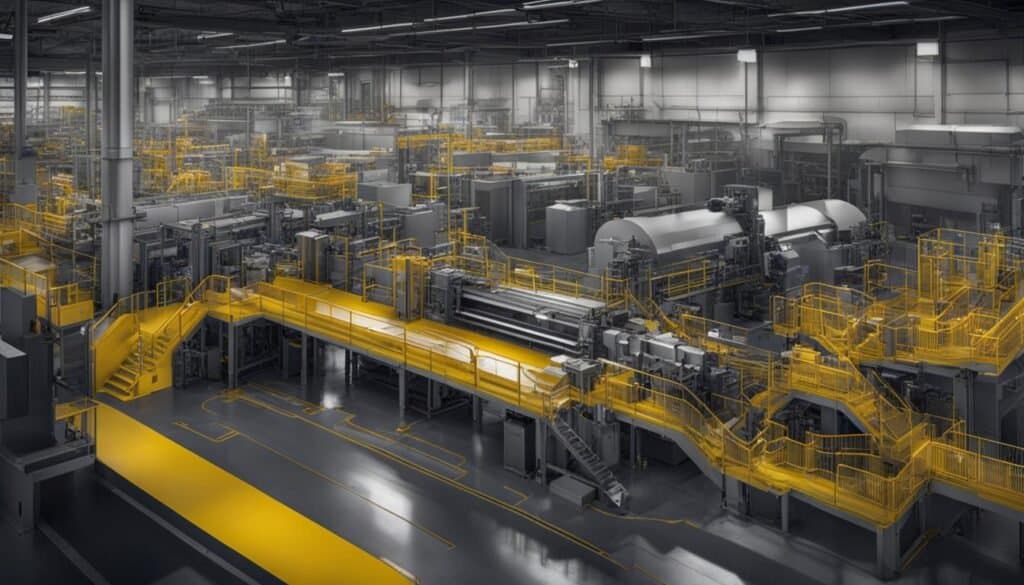
In the quest for waste reduction and process efficiency, value stream mapping is a powerful tool that allows manufacturers to visualize waste within their operations. This technique enables manufacturing facilities to create a visual representation of the flow of both materials and information throughout their processes, pinpointing inefficiencies and identifying opportunities to streamline operations and reduce waste.
Streamlining the Manufacturing Process
One of the primary goals of value stream mapping is to optimize the workflow within the manufacturing process. By systematically analyzing each step and process, manufacturers can identify specific areas of improvement and make data-driven decisions to reduce waste and enhance process efficiency. Value stream mapping can assist in:
- Reducing setup time
- Addressing bottlenecks in the process
- Eliminating unnecessary steps and movement
- Minimizing wait times and downtime
- Optimizing inventory levels and management
A successful value stream mapping exercise can result in a more streamlined manufacturing process that utilizes fewer resources and generates less waste, while still delivering high-quality products to customers.
Identifying Areas of Improvement
Value stream mapping not only helps visualize waste but also encourages a continuous improvement culture within the organization. By conducting regular waste audits and refining the waste stream analysis, manufacturers can always stay on top of the areas that need improvement and address them promptly. This ongoing evaluation ensures that manufacturers are consistently working towards enhancing process efficiency and achieving waste reduction goals.
“The first step in solving a problem is to recognize that it does exist.” – Zig Ziglar
To successfully implement value stream mapping and truly reap its benefits, organizations must commit to a culture of continuous improvement and be willing to address waste in all its forms – from material consumption to energy usage. By maintaining this focus on waste reduction and efficiency, manufacturers can create a sustainable and profitable future for themselves and the environment.
Total Productive Maintenance to Prevent Downtime and Defects
One of the essential waste reduction strategies in manufacturing is adopting a total productive maintenance (TPM) approach designed to prevent downtime and reduce defects in the production line. TPM emphasizes proactive and preventive upkeep strategies for ensuring overall equipment efficiency and reliability.
Let’s dive into the key components of TPM.
Regular Maintenance Schedule
To optimize equipment performance and extend its life cycle, a well-structured maintenance schedule should be in place. Scheduled maintenance activities include routine inspections, cleaning, adjustments, and replacements required to ensure equipment’s efficient operation.
Predictive Maintenance
One of the milestones in a TPM strategy is incorporating predictive maintenance, which involves using data and advanced sensors to monitor the condition of equipment, accurately pinpointing potential issues before they become critical. By addressing potential problems early, manufacturers can minimize downtime and costly repairs.
Equipment Efficiency
Equipment efficiency lies at the heart of TPM. A well-maintained machine leads to fewer breakdowns, reducing production delays and defects. Regular maintenance also mitigates the risk of equipment-related accidents, contributing to a safer work environment.
Benefits of Total Productive Maintenance
Implementing TPM strategies leads to:
- Improved equipment efficiency and reliability
- Reduced downtime and production delays
- Fewer defects due to proper functioning of equipment
- Lower maintenance costs in the long run
- Enhanced worker safety
“A properly executed TPM strategy can transform productivity and minimize unforeseen downtime, ultimately increasing profit margins and ensuring a smoother, more efficient production process.”
To sum it up, a comprehensive total productive maintenance plan enhances the manufacturing process by increasing equipment efficiency, preventing downtime, and reducing defects. This method not only supports a leaner and more sustainable manufacturing model but also contributes to overall profitability and competitive advantage.
Implementing 5S Methodology for Workplace Organization
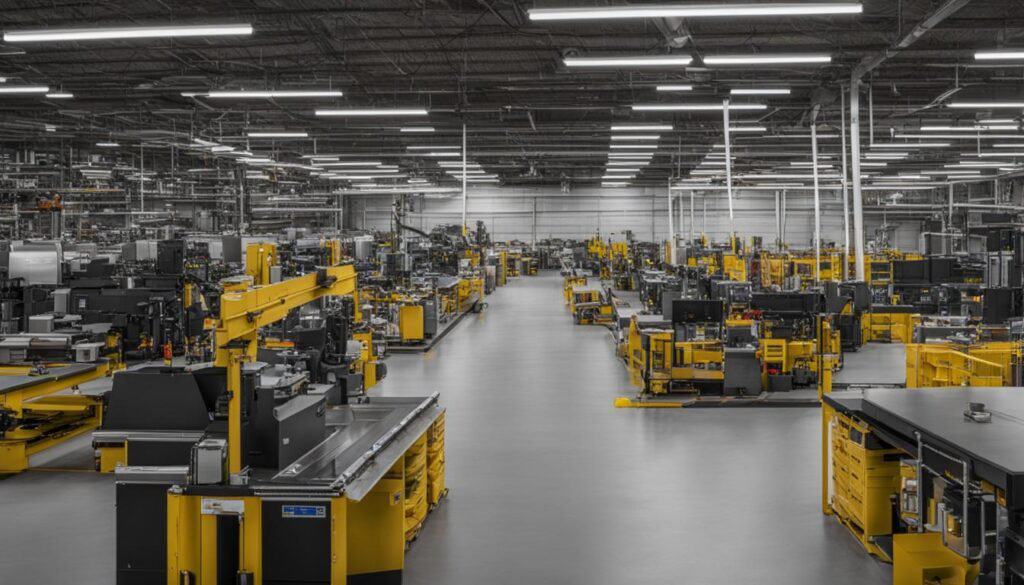
The 5S methodology is a proven approach to workplace organization that significantly reduces waste and optimizes productivity. By maintaining an orderly workplace and fostering standardized work procedures, it lays the groundwork for long-term efficiency gains and enhanced employee engagement. In this section, we’ll explore the key components of this method and learn how to implement them effectively within a manufacturing setting.
| 5S Element | Description |
|---|---|
| Sort | Sort means to separate needed items from unneeded ones and remove the latter. This step involves evaluating items and keeping only what’s necessary for daily tasks. |
| Set in Order | Set in Order involves organizing and arranging items for ease of use. This step focuses on efficient and effective storage methods, ensuring that each item has a designated place. |
| Shine | Shine refers to cleaning the workspace and equipment. Regular cleaning and maintenance ensure that spaces and equipment are ready for use and identify potential issues before they become significant problems. |
| Standardize | Standardize is about creating norms and standards for processes and organization. This step ensures consistency in how tasks are performed and how items are stored, making processes more efficient and predictable. |
| Sustain | Sustain involves maintaining and reviewing standards. Once the first four steps are implemented, this step focuses on ongoing practice of these principles and continuous improvement. |
This 5S methodology is a foundational part of lean management, focusing on workplace organization, efficiency, and continuous improvement.
Sorting and Standardizing Workflow
Sorting and standardizing processes play a crucial role in the 5S methodology. The first step, sorting, focuses on identifying and separating necessary items from unnecessary ones, thereby decluttering the workplace and simplifying the workflow. The subsequent step, standardizing, aims to establish clear guidelines and procedures for routines and tasks, ensuring consistency and reducing setup time.
“The objective of 5S is to create and maintain a well-organized, efficient, and productive workplace.”
Among the techniques employed to streamline workflow are:
- Setup time reduction
- Line balancing
- Establishing a systematic approach for executing tasks
These measures ultimately lead to improved workplace efficiency and a more productive manufacturing environment.
Shifting Mindsets Towards Systematic Cleaning and Sustaining
Once the aforementioned sorting and standardizing procedures have been implemented, it’s essential to develop a mindset of systematic cleaning and sustaining improvements. This ensures that the workplace remains organized and that the 5S principles continue to be followed.
| Employee Engagement Strategies | Benefits |
|---|---|
| Involving employees in the development and implementation of 5S initiatives | Increases ownership and buy-in |
| Providing regular training and reinforcement of 5S standards | Ensures consistent understanding and application of Best Practices |
| Recognizing and rewarding employees who adhere to and promote 5S principles | Promotes a culture of continuous improvement and high performance |
By fostering employee engagement, businesses can ensure that the 5S methodology remains an integral part of the workplace culture, driving efficiency gains and maintaining a clean, organized environment for all.
The Role of Kanban System in Inventory Management
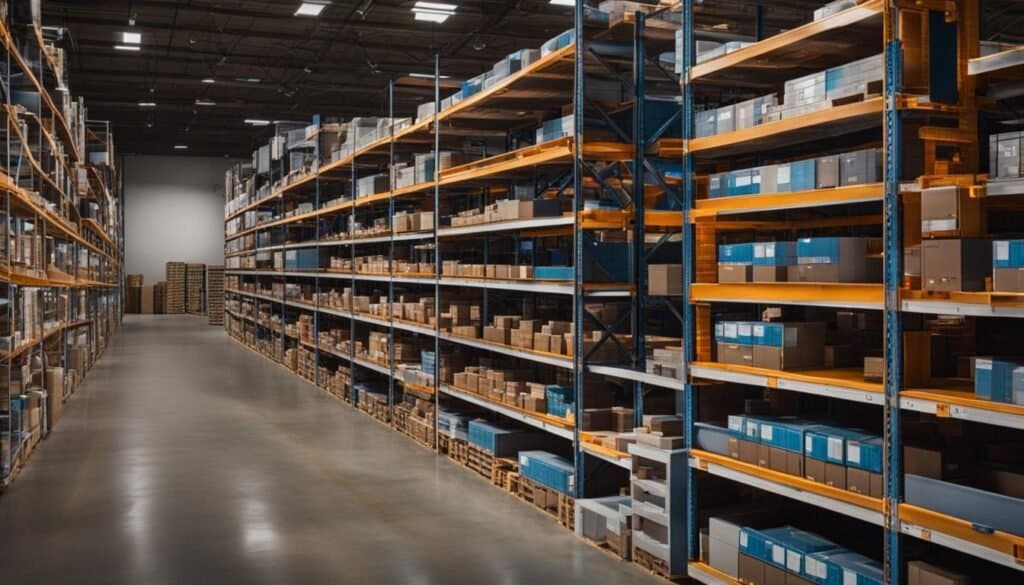
Implementing the Kanban system within a manufacturing environment enhances inventory management, streamlining processes for improved efficiency and leading to decreased accumulation of excess inventory. Designed in the mid-twentieth century by Taiichi Ohno, an industrial engineer at Toyota, the Kanban system is built upon the principles of visual management and just-in-time production, aligning seamlessly with lean manufacturing methodologies.
At its core, the Kanban system emphasizes creating a continuous production flow, with a goal of minimizing idle time within the manufacturing process, thereby maximizing productivity. The key to achieving this lies in efficiently managing inventory levels, ensuring an optimal balance between raw materials and finished goods to maintain a steady workflow and reduce excess raw materials.
“Kanban is like a supermarket. You only take what you need from the shelves and as items are withdrawn from the stockroom, the shelves are replenished with only the quantity that was withdrawn.” – Taiichi Ohno
Notably, the Kanban system is highly adaptable, with the potential for implementation across various industries, spanning from software development to logistics management. Within the context of inventory management, Kanban is particularly effective for manufacturers focused on reducing waste streams and striving for operational excellence.
- Visualizing Workflow: The Kanban system relies on the use of visual cues, typically in the form of cards or signals, representing individual work items as they pass through distinct stages of the production process.
- Limiting Work in Progress (WIP): By imposing limits on the number of active work items within a particular stage, the Kanban system promotes a focus on task completion and efficient resource deployment, countering the pitfalls of overproduction and excess inventory.
- Measuring and Monitoring: Production rates are monitored and analyzed using key performance indicators (KPIs), allowing organizations to identify areas for improvement and drive the ongoing refinement of inventory control practices based on real-time data.
The benefits of implementing a Kanban system within inventory management extend far beyond raw material waste reduction and improved production flow. Advantages also include:
- Clearer communication among team members due to visual cues and progress tracking;
- Improved adaptability to customer demand fluctuations;
- Enhanced transparency of operations, allowing for expedited identification of bottlenecks and other process inefficiencies; and
- Promotion of a culture of continuous improvement, as teams regularly scrutinize and refine production methodologies in response to real-time performance data.
Ultimately, the Kanban system offers a valuable tool for manufacturers seeking to strengthen the way they manage inventory and embrace the principles of lean production. By streamlining workflows, promoting transparency and responsiveness, and fostering a culture of continuous improvement, the Kanban system can contribute significantly to reducing waste, promoting efficiency, and advancing a company’s competitive posture within the global manufacturing landscape.
Integrating Cellular Manufacturing for Enhanced Flow
Cellular manufacturing is a production approach that aims to optimize workflow, reduce manufacturing waste, and enhance overall organization. By grouping machines and processes based on similar tasks or product families, cellular manufacturing significantly improves the production flow, reduces the motion waste, and ensures a more efficient and cost-effective system.
Reduction of Motion Waste Through Effective Layout Planning
One of the primary goals of cellular manufacturing is the reduction of motion waste. In a traditional manufacturing setup, machines are often organized according to their specific functions, which can result in excessive movements, delays, and transportation of materials as workers move between machines and areas. With effective layout planning, cellular manufacturing reorganizes the workspace to minimize these unnecessary movements and to streamline production.
“Cellular manufacturing seeks to improve the efficiency and productivity of a production facility by reorganizing machinery and workspaces for optimal flow and minimal movement. “
Several key benefits come from implementing cellular manufacturing:
- Reduced travel distances and handling times for materials, products, and tools.
- Easier monitoring and troubleshooting of the production process.
- Quicker machine setup and changeovers.
- Fewer defects and production errors.
- Enhanced worker productivity and employee morale.
A well-organized cellular manufacturing layout also places a focus on ergonomic improvements, which encourages worker safety, comfort, and productivity. By optimizing workspace design, employees can work more comfortably and efficiently, further reducing waste and boosting overall efficiency.
| Traditional Manufacturing Layout | Cellular Manufacturing Layout |
|---|---|
| • Machines organized by function. | • Machines grouped based on similar tasks or product families. |
| • Lengthy distances between machines, causing unnecessary movements and transportation. | • Shorter distances between machines, reducing motion waste and handling times. |
| • Longer machine setup and changeover times. | • Faster and more efficient machine setup and changeovers. |
| • Lack of ergonomic considerations. | • Ergonomic improvements for employee safety and productivity. |
| • Difficulty in monitoring and troubleshooting the production process. | • Better visibility and control over the production process. |
In conclusion, integrating cellular manufacturing is an effective strategy to enhance the production flow, reduce motion waste, and create a more efficient workspace. Adopting this approach can lead to significant improvements in productivity, waste reduction, and worker safety, ultimately contributing to the success and sustainability of a manufacturing facility.
Measuring Overall Equipment Effectiveness (OEE) for Continuous Improvement
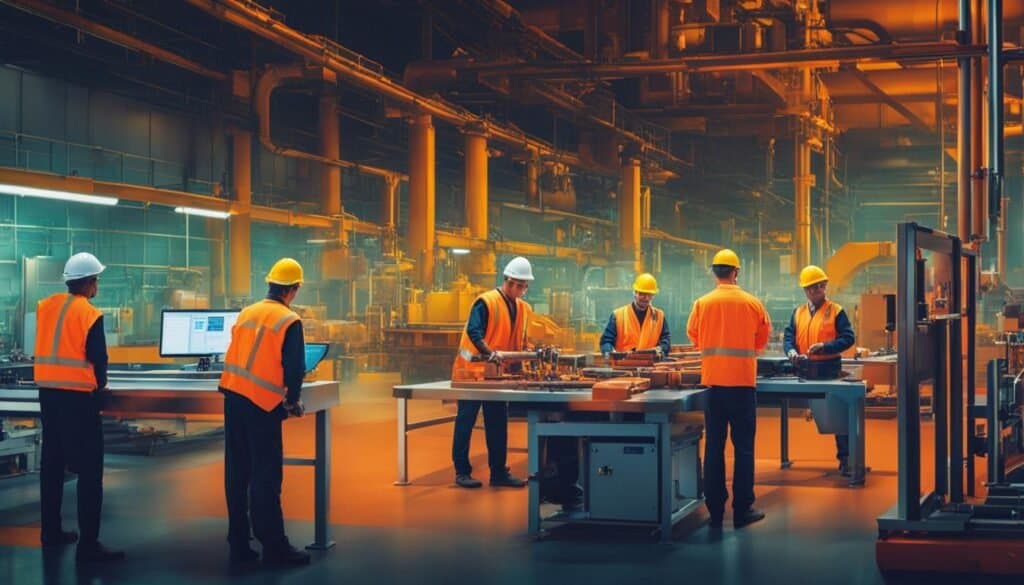
One of the most essential aspects of continuous improvement is the efficient utilization of manufacturing equipment. This is where Overall Equipment Effectiveness (OEE) comes into play. It serves as a critical metric for assessing the effectiveness of manufacturing equipment, providing key insights into machinery performance and identifying areas that require targeted enhancements.
By keeping track of OEE, manufacturers can have a better understanding of their equipment’s reliability, availability, and performance. This data-driven approach allows manufacturers to optimize their operations, leading to significant improvements in overall production efficiency.
“You can’t improve what you don’t measure.”
The three main components of OEE are:
- Availability – the percentage of planned production time that is actually productive
- Performance – the rate at which equipment operates relative to its maximum potential
- Quality – the ratio of good quality output to total output produced
Performance monitoring software, such as manufacturing execution systems, enables real-time tracking of equipment, collects valuable data, and calculates OEE scores. This performance information is crucial for identifying areas that necessitate improvement and strategizing tailored solutions to drive enhanced productivity.
By constantly analyzing OEE, manufacturers can uncover inefficiencies and monitor progress in their continuous improvement journey. Let’s look at an example:
| Categories | Current OEE (%) | Target OEE (%) |
|---|---|---|
| Availability | 80 | 90 |
| Performance | 75 | 85 |
| Quality | 88 | 95 |
| Overall OEE | 53 | 73 |
In the table above, the target OEE rates have been established across different categories. The manufacturers can now strive towards achieving these goals by implementing strategic actions, such as predictive maintenance, operator training, and process optimization, to effectively raise their OEE.
Monitoring OEE scores drives manufacturers to adapt to the dynamic manufacturing environment, track the effectiveness of their continuous improvement efforts, and foster a culture of excellence within their organization.
Conclusion on Reduce Manufacturing Waste
In summary, achieving waste reduction success in manufacturing can significantly enhance productivity and create a real positive environmental impact. A commitment to lean manufacturing principles, sustainable manufacturing, and embracing technological advances paves the way for a greener and more efficient production landscape.
By integrating these waste reduction strategies and fostering a culture of continuous improvement, manufacturing companies can effectively adapt to current and future industry challenges while staying competitive. This forward-thinking, innovative approach to manufacturing not only benefits the immediate operations but also greatly contributes to long-term sustainability.
Ultimately, it is essential to understand that waste reduction and efficiency in the manufacturing sector are not only about resource optimization but also a driving force for environmental preservation and fostering innovation in manufacturing. It is a collective responsibility for companies across the industry to adopt and implement these strategies to ensure a more sustainable and prosperous future.
FAQ on Waste Reduction Strategies in Manufacturing
Q: What are the top waste reduction strategies in manufacturing?
A: The top waste reduction strategies in manufacturing include implementing lean manufacturing principles, conducting preventive maintenance, optimizing production processes, and utilizing recycling and reuse methods.
Q: How can manufacturers boost efficiency by reducing waste?
A: Manufacturers can boost efficiency by reducing waste through the implementation of waste management strategies, minimizing overproduction, optimizing inventory management, and using manufacturing software for better productivity.
Q: What are the types of manufacturing waste that can be reduced?
A: Types of manufacturing waste that can be reduced include overproduction waste, packaging waste, plastic waste, and production waste, among others.
Q: Are there specific ways to reduce manufacturing waste?
A: Yes, there are specific ways to reduce manufacturing waste such as minimizing waste material, implementing lean manufacturing principles, and utilizing recycling and reuse methods.
Q: How can waste management be improved in manufacturing?
A: Waste management in manufacturing can be improved by optimizing production processes, implementing efficient waste disposal methods, and using inventory management software to track and minimize waste.
Q: What role does recycling play in waste reduction in manufacturing?
A: Recycling plays a crucial role in waste reduction in manufacturing by reusing recyclable materials, minimizing the amount of waste sent to landfills, and promoting a more sustainable approach to waste management.
Q: How can manufacturers minimize production waste?
A: Manufacturers can minimize production waste by adopting lean manufacturing principles, optimizing production processes, reducing overproduction, and implementing effective inventory management to reduce the amount of waste generated.
Q: What are the benefits of reducing waste in manufacturing?
A: The benefits of reducing waste in manufacturing include cost savings, improved productivity, environmental sustainability, and a more efficient use of resources, ultimately leading to better manufacturing productivity.
Q: How can manufacturers reduce or eliminate unnecessary waste in production?
A: Manufacturers can reduce or eliminate unnecessary waste in production by implementing lean manufacturing principles, conducting regular waste audits, and optimizing their production processes to minimize the waste generated.
Q: How does minimizing waste contribute to a more efficient manufacturing business?
A: Minimizing waste contributes to a more efficient manufacturing business by reducing costs, improving resource utilization, and enhancing overall productivity, leading to a more streamlined and sustainable manufacturing process.

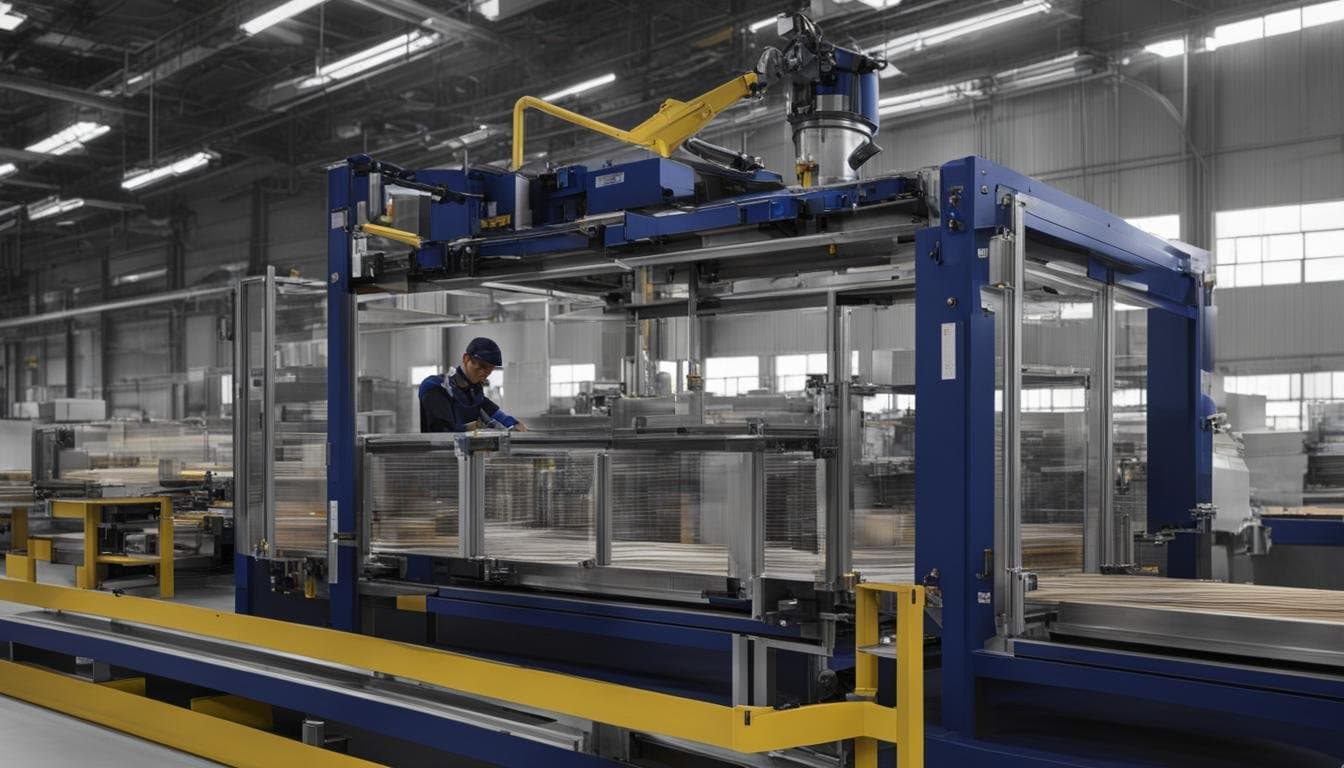



Leave a Reply